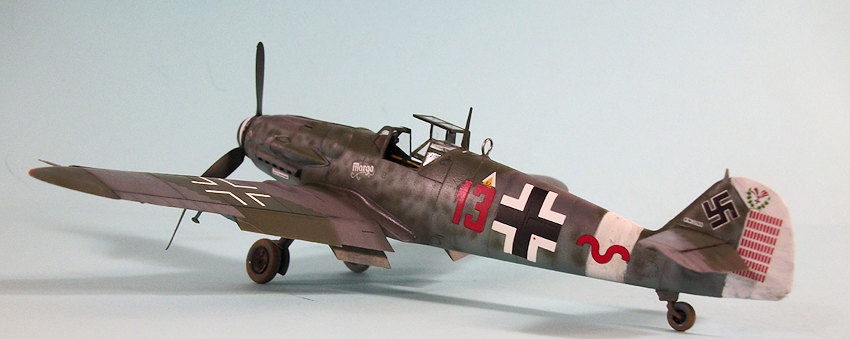
Eduard 1/48 Bf-109G-6 (late)
| KIT #: | 82111 |
| PRICE: | $45.00 |
| DECALS: | Five options |
| REVIEWER: | Tom Cleaver |
| NOTES: | Retooled version. EagleCals #28, “Bf-109G-6s,” used |

| HISTORY |
By 1943, it was clear to the Luftwaffe that the lightly armed Bf 109G 2 and G 4 fighter (1 20mm cannon, 2 7.62mm machine guns) was underarmed. In the West, the Jagdgeschwaders were equipped with two Fw 190 Gruppen for anti bomber operations and one Bf 109G Gruppe to take on the escort fighters. More and more, though, both types were used against the bombers, and fighters like the P 47 were remarkably resistant to rifle caliber machine gun fire.
The Bf 109G 6
variant was the most produced Gustav sub type, first appearing in the fall of
1943 and constituting the major equipment of Bf 109 equipped
Jagdstaffeln
until the fall of 1944. The airframe could accept several versions of the DB605A
from the spring of 1944, the DB605D could also be installed. GM1 or MW50 could
be used for increasing engine power. MW50 boosted takeoff power from 1,475 h.p.
to 1,800 h.p., at the cost of reducing spark plug life and vastly increasing
fuel consumption. The sub type marked the first upgrade in armament since the
introduction of the Friedrich series. To accommodate the 13mm
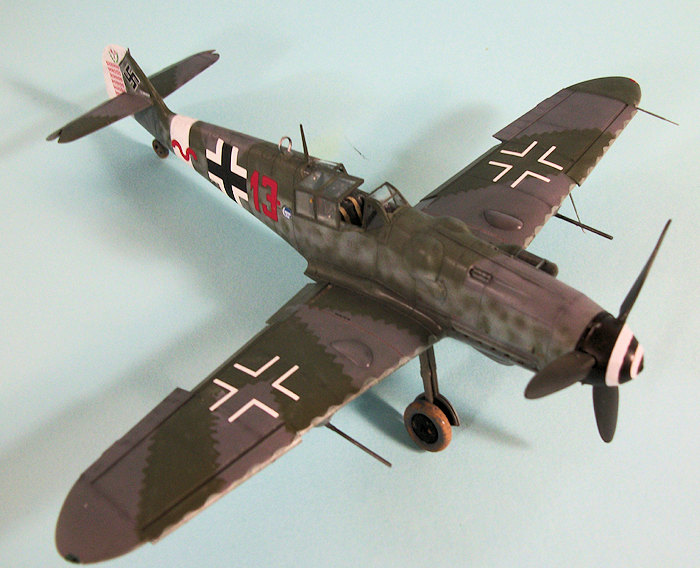 machine guns in
the cowling, Messerschmitt's engineers came up with remarkably non aerodynamic
bulges that quickly led to the G 6 being called the "Beule" (bumps) when it
arrived on operations. Inasmuch as Adolf Galland had managed to have a Bf 109F
modified with 13mm armament with very refined streamlined cowl bulges, one has
to wonder why that design could not be carried forward.
machine guns in
the cowling, Messerschmitt's engineers came up with remarkably non aerodynamic
bulges that quickly led to the G 6 being called the "Beule" (bumps) when it
arrived on operations. Inasmuch as Adolf Galland had managed to have a Bf 109F
modified with 13mm armament with very refined streamlined cowl bulges, one has
to wonder why that design could not be carried forward.
While this new armament was more than satisfactory when used against the Soviet aircraft on the Eastern front, it was apparent that even this upgrade was insufficient to assure a kill against the B 17 or B 24 in the limited amount of time a pilot had to bring his weapons to bear as he dove through the American formations. As early as the Bf 109F 4, the Ruestsaetze Sechs (R6) had been available as a field modification; this was a 20mm cannon in a gondola under each wing immediately outboard of the main gear wells. The heavy weapons had a deleterious effect on maneuverability in fighter vs. fighter combat, but in 1943 the Germans could afford to wait until the escort fighters turned back for lack of fuel, before commencing attacks on the bomber formations. Thus, the "Kannonenboot," or "gunboat" became the must numerous version of the G 6 to see combat in the West. Of course, later in the year, and in 1944, the gunboats would be "meat on the table" to P 47s and P 51s equipped with drop tanks that enabled them to escort the bombers to the target and back, and by late Spring 1944, the guns were no longer to be seen, replaced by a 30mm cannon in the nose.
JG27, the Afrika Geschwader, received Bf 109G 6s in the fall of 1943, after the unit had withdrawn from North Africa and been stationed in the Greek Islands, where their main opponents were Allied anti shipping strike aircraft. The majority of JG 27's Bf 109G 6s were equipped at this time with Rustsatze 6, two 20mm cannon in underwing gondolas, inasmuch as they were not primarily tasked with opposing Allied single engine fighters.
Among the pilots
assigned to IV Gruppe when it was activated in Greece in May 1943 was Feldwebel
Heinrich Bartels, who flew with 11 Staffel. Bartels was Austrian, and had worked
as a baker before joining the Luftwaffe after the
Anschluss.
In 1941 he was assigned to JG 26 on the Channel Front where he scored his first
victory in August. Bartels was transferred to
Jagdgeschwader 5
on the Eastern Front He claimed 47 Russian aircraft shot down in 100 combat
missions on the Arctic front, 21 of which were in the month of September 1942
alone and received the Knight's Cross of the Iron Cross (Ritterkreuz
des Eisernen Kreuzes)
after 46 aerial victories on November 13, 1942. Bartels was transferred to JG 27
following a court martial invol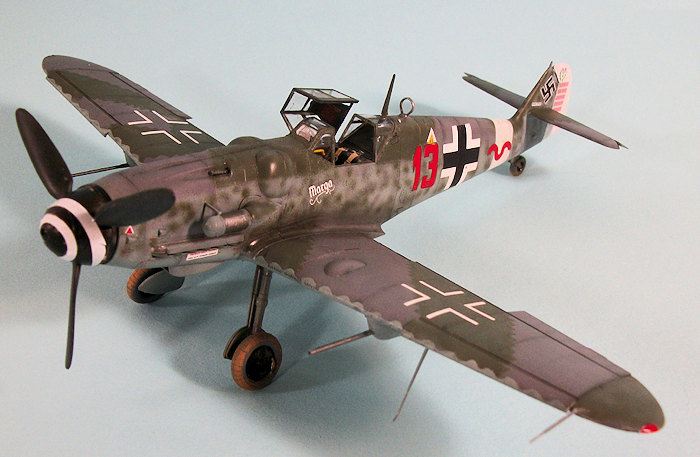 ving a disciplinary problem after excessive
consumption of alcohol and arrived just before the
Geschwader
left Africa. By the fall of 1943, when IV/JG 27 was based at Kalamaki, near
Athens, he was the leading ace with 70 victories.
ving a disciplinary problem after excessive
consumption of alcohol and arrived just before the
Geschwader
left Africa. By the fall of 1943, when IV/JG 27 was based at Kalamaki, near
Athens, he was the leading ace with 70 victories.
JG 27 was transferred to Hungary in March 1944 to face the 15th Air Force’s offensive. Bartels scored there to, before the unit was finally transferred to Germany for Defense of the Reich duties in the summer of 1944. Bartels was killed on December 23, 1944, while supporting German forces in the Battle of the Bulge. He was shot down by P 47 Thunderbolts of the 56th Fighter Group after achieving his 99th aerial victory. On January 23, 1968, 23 years later, Bartels' Bf 109 G 10 (Werknummer 130 359—factory number) "Yellow 13" was found in Villip near Bad Godesberg. In its cockpit was Bartels' remains and his intact parachute, which is currently on display at the Deutsches Technikmuseum Berlin.
His score totaled 99 victories in some 500 combat missions, with 49 on the Eastern Front, and included nine Spitfires, nine P 47s, eleven P 51s, and fourteen P 38s.
| THE KIT |
veryone is aware of
Eduard’s unfortunate history with the Bf-109G-6. The original kit was released
two years ago. Modelers who were expecting something the equal of the Spitfire
IX series were sadly disappointed, and a very vocal campaign against the kit
erupted on the model forums. To their credit, E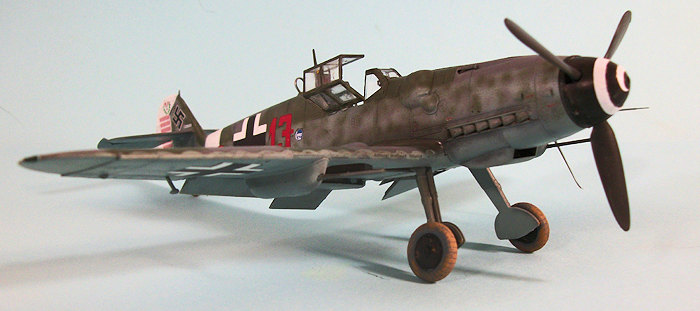 duard did respond to the
criticism, went back to their research, saw what they had done wrong, publicly
admitted their mistakes, and declared they would go back to the drawing board
and get it right.
duard did respond to the
criticism, went back to their research, saw what they had done wrong, publicly
admitted their mistakes, and declared they would go back to the drawing board
and get it right.
This kit is the result of that effort, and it achieves everything that was originally expected. It is the equal of the Spitfires in terms of accuracy and kit production quality. While this release is billed as the “late version,” the parts are there to do any version of the Bf-109G-6 (and G-5) family a modeler wants. There are two types of tall rudder as well as the classic rudder, underwing cannons, bomb racks for the fuselage, two different kinds of drop tank. There is the standard heavy canopy and two types of later canopies, as well as different windscreens. Other detail parts on the tree demonstrate that Eduard is going to do every Bf-109 from the F-2 to the G-14.
The kit provides excellent decals for five aircraft.
| CONSTRUCTION |
This is easily the least-fiddly 1/48 kit Eduard has yet released. It is simpler in production design than the earlier G-6 kit was. Modelers who want a super-detailed cockpit may opt for one of the many resin cockpits out there, but for most what is in the kit will be fine - particularly since it’s all dark grey RLM66 anyway. The fit is very precise and you must take the time to completely clear off any sprue nubs, and keep paint off the mating surfaces since that would be enough to throw things off.
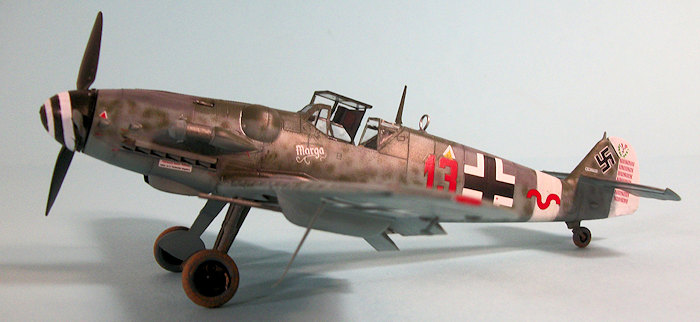 After assembling and
painting the cockpit, I assembled the fuselage and then assembled the wing, and
joined the two sub-assemblies, then added on the horizontal stabilizers. All the
control surfaces are separate; the kit is designed to have the flaps lowered and
the radiator flaps open. I used the “classic” vertical fin and rudder.
After assembling and
painting the cockpit, I assembled the fuselage and then assembled the wing, and
joined the two sub-assemblies, then added on the horizontal stabilizers. All the
control surfaces are separate; the kit is designed to have the flaps lowered and
the radiator flaps open. I used the “classic” vertical fin and rudder.
I had already determined I was going to do an earlier Bf-109G-6, and settled on Bartels’ famous “Rot Dreizehn”, which is a very colorful airplane. There are not really a lot of photos of the airplane, but there is one in particular that is important, since enough of the left wing is shown to demonstrate that the airplane was finished in the “Erla-style” zig-zag camouflage. This means that, while it was a G-6, it would have had the “Erla Buele” on the right side first developed for the G-5. All illustrations of this airplane show it with the standard “bump” on the right, but the camouflage is determinative. Erla did all their G-5s and G-6s with the same piece.
I freehanded the 74/75/76 camouflage, then took a 0000 brush and hand-painted the “zig-zags. I used the EagleCals sheet #28 to create the airplane.
| CONCLUSIONS |
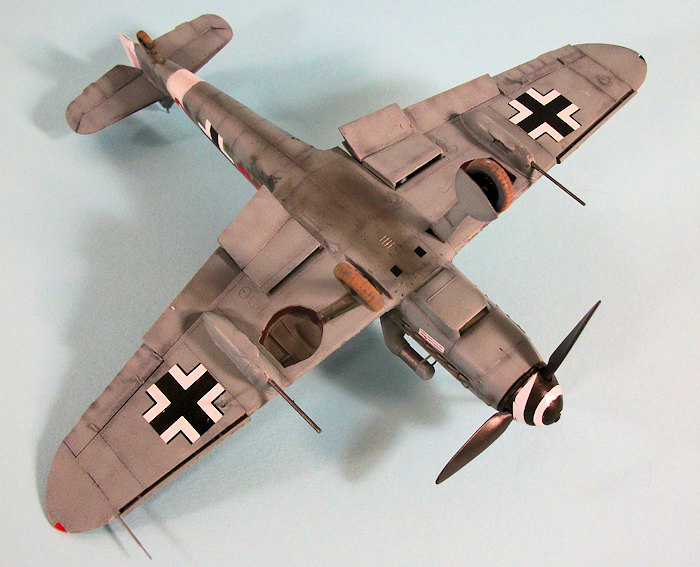 Definitely the best
Bf-109G-6 out there, and well worth the price of admission. Look around for
Internet bargains; the MSRP is around $45, but deals for $36 or so are common at
the usual suspects. With it’s non-fiddly kit design, any modeler willing to take
the time and follow the instructions will be guaranteed an outstanding model.
Highly recommended.
Definitely the best
Bf-109G-6 out there, and well worth the price of admission. Look around for
Internet bargains; the MSRP is around $45, but deals for $36 or so are common at
the usual suspects. With it’s non-fiddly kit design, any modeler willing to take
the time and follow the instructions will be guaranteed an outstanding model.
Highly recommended.
16 June 2016
Review kit courtesy of my wallet.
If you would like your product reviewed fairly and fairly quickly, please contact the editor or see other details in the Note to Contributors.